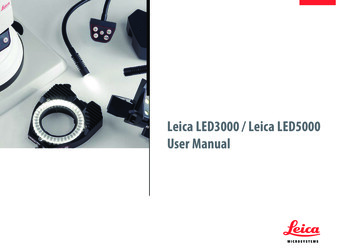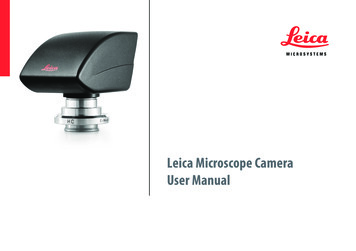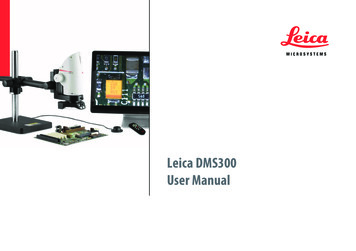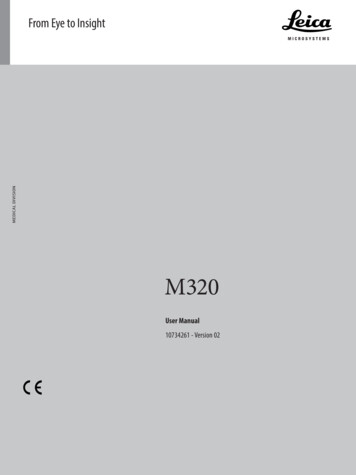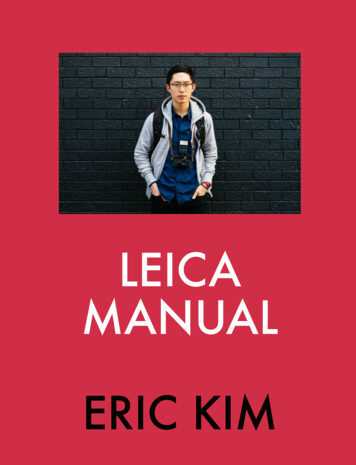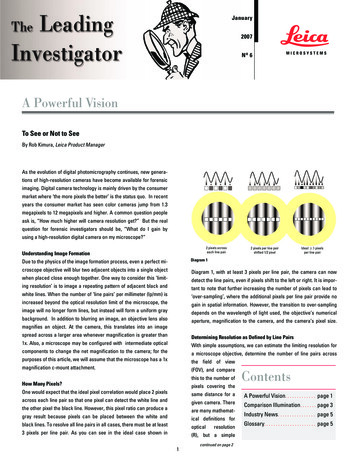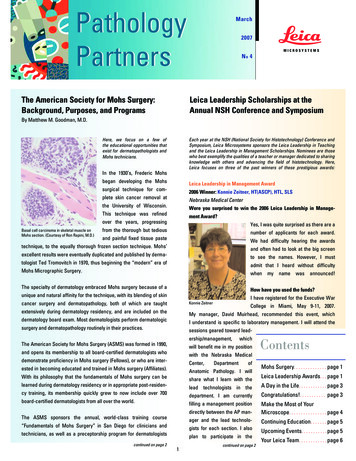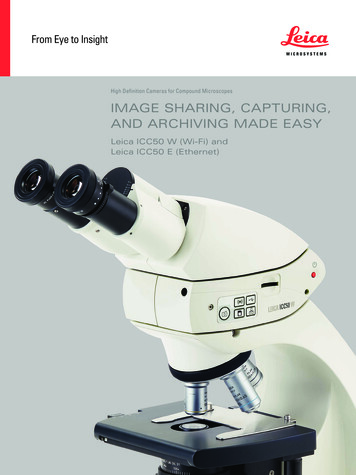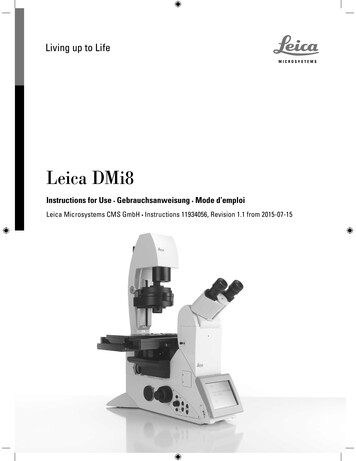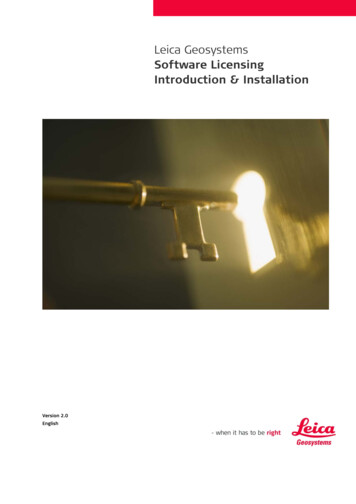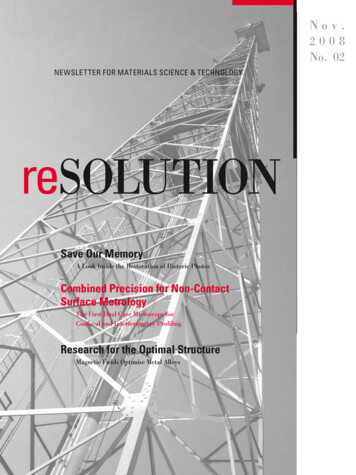
Transcription
Leica CM1860/CM1860 UVCryostatInstructions for UseEnglishOrder No.: 14 0491 80101 - Revision SAlways keep this manual with the instrument.Read carefully before working with the instrument.Version 2.5, Revision S - 11.2021
NoteThe information, numerical data, notes and value judgments contained in this Instructions for Userepresent the current state of scientific knowledge and state-of-the-art technology as we understand itfollowing thorough investigation in this field.We are under no obligation to update the present Instructions for Use periodically and on an ongoingbasis according to the latest technical developments, nor to provide our customers with additionalcopies, updates etc. of this Instructions for Use.To the extent permitted in accordance with the national legal system as applicable in each individualcase, we shall not be held liable for erroneous statements, drawings, technical illustrations etc. containedin this Instructions for Use. In particular, no liability whatsoever is accepted for any financial loss orconsequential damage caused by or related to compliance with statements or other information in thisInstructions for Use.Statements, drawings, illustrations and other information regarding the contents or technical details ofthe present Instructions for Use are not to be considered warranted characteristics of our products.These are determined only by the contract provisions agreed between ourselves and our customers.Leica reserves the right to change technical specifications as well as manufacturing processes withoutprior notice. Only in this way is it possible to continuously improve the technology and manufacturingtechniques used in our products.This document is protected under copyright laws. All copyrights to this documentation are held by LeicaBiosystems Nussloch GmbH.Any reproduction of text and illustrations (or of any parts thereof) by means of print, photocopy,microfiche, web cam or other methods – including any electronic systems and media – requires expressprior permission in writing by Leica Biosystems Nussloch GmbH.For the instrument serial number and year of manufacture, please refer to the nameplate on the back ofthe instrument.Leica Biosystems Nussloch GmbHHeidelberger Strasse 17 - 1969226 NusslochGermanyTel.: 49 - (0) 6224 - 143 0Fax: 49 - (0) 6224 - 143 268Web:www.LeicaBiosystems.comLeica CM1860/CM1860 UV3
Table of contents1.Important Information.61.11.21.31.42.Symbols used in the text and their meaning. 6Qualification of personnel.10Intended purpose.11Instrument type.11Safety. 122.12.22.32.3.12.3.22.42.52.62.72.82.8.1Safety Notes.12Warnings.13Safety devices.13Locking/unlocking the handwheel.14Safety guard.14Operating Conditions.15Operating the instrument.15Cleaning and disinfection.16Removing the microtome.17Maintenance.17Cleaning up a broken UVC lamp.183.Technical Data. 194.Installing the Instrument. 224.14.24.34.45.Instrument Setup. 285.15.25.35.45.56.Electrical connection.28Preparations for starting up the instrument.28General overview of the Leica CM1860/CM1860 UV.30Power switch and circuit breaker.32Switching on the instrument.32Operating the Instrument. .54Installation site requirements.22Unpacking instructions for the Leica CM1860/CM1860 UV cryostat.23Standard delivery - packing list.26Installing the handwheel.27Control panel 1.33Configuring the desired values.35Setting the time.35Setting the automatic defrost time (cryochamber).35Programming the temperature of the cryochamber.36Activating the Peltier element.36Manual defrosting of the quick freeze shelf.37Manual defrosting of the cryochamber.38Setting the section thickness.38Retraction.39Display lock.39Control panel 2 – Electric coarse feed.40Version 2.5, Revision S
Table of contents 7.Daily Use of the Instrument. Troubleshooting. 648.18.28.38.3.19.Error messages in the display.64Temperature control button.65Possible sources of error, causes and remedies.66Changing the battery.69Cleaning, Disinfection, Maintenance. 709.19.29.39.3.19.3.29.3.39.3.410.The sectioning process .41Specimen freezing.41Quick-freeze shelf.42Specimen discs.43Inserting the specimen discs into the specimen head.43Specimen orientation.43Sectioning.44Inserting the blade/knife holder base.44Clearance angle adjustment.45Premium blade holder.46Blade holder CE.46Blade holder CE-TC.52Knife holder CN.53Cleaning the blade and knife holders.57Temperature selection chart (in minus C).60Defrosting.61Automatic defrosting of the cryochamber.61Manual defrosting of the cryochamber.61Manual defrosting of the quick freeze shelf.62Ending work.62Finishing the daily routine.62Switching off the instrument for a longer period.63Cleaning.70Disinfection at room temperature.70Maintenance.71General maintenance instructions.71Replacing the fuses.74Replacement of the UVC lamp.74Replacing the LED illumination.78Ordering Information, Components and Consumables. 7910.110.210.310.410.5Ordering information.79Mobile heat extractor - application.102Cold extraction - using the Thermal block.103Stationary heat extractor (optional) - application.104Installing the shelf (movable) (optional).10411.Warranty and Service. 10512.Decontamination Certificate. 106Leica CM1860/CM1860 UV5
1Important Information1.Important Information1.1Symbols used in the text and their meaningWarningLeica Biosystems Nussloch GmbH assumes no liability for consequential loss or damage due to failureto observe the following instructions, particularly in relation to transportation and package handling,and failure to observe the instructions for handling the instrument carefully.Symbol:Title of the symbol:Description:Hazard warningWarnings are displayed in a white field with an orangetitle bar and are marked by a warning triangle.Symbol:Title of the symbol:Description:NoteNotes, i.e. important information for the user,are displayed in a white field with a blue title barand are marked by a notification symbol.Symbol: "Fig. 7 - 1"Title of the symbol:Description:Symbol:Power switchTitle of the symbol:Description:Symbol:SaveTitle of the symbol:Description:Symbol:Title of the symbol:Description:Symbol:Title of the symbol:Description:Symbol:Title of the symbol:Description:Item numberItem numbers for numbering illustrations. Numbersin red refer to item numbers in illustrations.Buttons and switches on the instrumentButtons and switches on the instrument that aresupposed to be pressed by the user in varioussituations are displayed as bold, gray text.Function keySoftware symbols that have to be pressed on thedisplay or information that is output on the display aredisplayed as bold, gray text.NoticeIndicates the need for the user to consult theInstructions for Use for important cautionaryinformation such as warnings and precautions thatcannot, for a variety of reasons, be presented on themedical device itself.Warning, biological hazardInstrument parts close to this symbol may becontaminated with substances that pose a threatto health. Avoid direct contact or use appropriateprotective clothing.Warning, low temperature / freezing conditionsInstrument parts close to this symbol are exposedto low temperatures / freezing conditions thatpose a threat to health. Avoid direct contact or useappropriate protective clothing, e.g. frost protectiongloves.6Version 2.5, Revision S
Important Information1Symbol:Title of the symbol:Description:Caution: UVC radiation!Parts near this label emit ultraviolet radiation whenUV disinfection is turned on. Avoid any unprotectedcontact.Symbol:Title of the symbol:Description:Symbol:Title of the symbol:Description:Caution: UVC lamp contains MercuryThe UVC lamp contains mercury, which poses ahealth hazard when released. Any damaged UVClamp needs to be replaced immediately. Furthersafety measures apply. Follow the instructions in( P. 17 – Replacement of the UVC lamp) and ( P. 18 – 2.8.1 Cleaning up a broken UVC lamp) if aUVC lamp is damaged or even broken. Also follow theinstructions of the manufacturer of the UVC lamp.Warning – Hot surfaceWarns of a hot surface in normal and single faultconditions of evaporator and condenser.Symbol:Title of the symbol:Description:ManufacturerIndicates the manufacturer of the medical device.Symbol:Title of the symbol:Description:Date of ManufactureIndicates the date when the medical device wasmanufactured.Symbol:Title of the symbol:Description:Symbol:Title of the symbol:Description:Symbol:Title of the symbol:Description:CE LabelThe CE marking is the manufacturer's declaration thatthe medical product meets the requirements of theapplicable EC directives and regulations.UKCA LabelThe UKCA (UK Conformity Assessed) marking is anew UK product marking that is used for goods beingplaced on the market in Great Britain (England, Walesand Scotland). It covers most goods which previouslyrequired the CE marking.In vitro diagnostic medical deviceIndicates a medical device that is intended to be usedas an in vitro diagnostic medical device.Symbol:Title of the symbol:Description:Leica CM1860/CM1860 UVChina RoHSEnvironmental protection symbol of the China ROHSdirective. The number in the symbol indicates the"Environment-friendly Use Period" of the product inyears. The symbol is used if a substance restrictedin China is used in excess of the maximum permittedlimit.7
1Important InformationSymbol:Title of the symbolDescription:Symbol:Title of the symbol:Description:Symbol:Title of the symbol:Description:Symbol:Title of the symbol:Symbol:Title of the symbol:Description:Article numberIndicates the manufacturer's catalog number so thatthe medical device can be identified.Symbol:Title of the symbol:Description:Serial numberIndicates the manufacturer's serial number so that aspecific medical device can be identified.Symbol:Title of the symbol:Description:Consult Instructions for UseIndicates the need for the user to consult theInstructions for Use.Symbol:Title of the symbol:Description:Flammable liquidPackage labeling in accordance with GermanHazardous Freight Ordinance Road and Rail (GGVSE)/European Agreement concerning the InternationalCarriage of Dangerous Goods by Road (ADR) fortransporting hazardous goods.Symbol:8Title of the symbol:Description:CSA test symbol (USA/Canada)The CSA test symbol means that a product hasbeen tested and fulfills the applicable safety and/or performance standards, including the relevantstandards defined or administered by the AmericanNational Standards Institute (ANSI), UnderwritersLaboratories (UL), the Canadian StandardsAssociation (CSA), the National Sanitation FoundationInternational (NSF) and others.Country of OriginThe Country of Origin box defines the country wherethe final character transformation of the product hasbeen performed.WEEE symbolThe WEEE symbol, indicating the separatedcollection of electrical and electronic equipmentwastes, consists of the crossed-out wheeled bin(§ 7 ElektroG).Alternating currentClass 3: FLAMMABLE LIQUID.Flammable freezing sprays prohibitedThis symbol alerts the user that the use of flammablefreezing sprays in the cryostat chamber is prohibiteddue to explosion hazard.Version 2.5, Revision S
Important InformationSymbol:Title of the symbol:Description:1IPPC symbolThe IPPC symbol includes:IPPC symbol Country code in accordance with ISO 3166,e.g. DE for Germany Regional identifier, e.g. NW for NorthRhine-Westphalia Producer/treatment provider code, uniquelyassigned number starting with 49 Treatment method, e.g. HT (heat treatment)Do not stackStacking of the transport packages is not allowed andno load should be placed on the transport packages.Symbol:Title of the symbol:Description:Symbol:Title of the symbol:Description:Fragile, handle with careIndicates a medical device that can be broken ordamaged if not handled carefully.Symbol:Title of the symbol:Description:Keep dryIndicates a medical device that needs to be protectedfrom moisture.Symbol:Title of the symbol:Description:UpperIndicates the correct upright position of the package.Symbol:Title of the symbol:Description:Temperature limit for transportIndicates the temperature limits for transport to whichthe medical device can be safely exposed.Symbol:Title of the symbol:Description:Temperature limit for storageIndicates the temperature limits for storage to whichthe medical device can be safely exposed.Leica CM1860/CM1860 UV9
1Important InformationSymbol:Title of the symbol:Description:Humidity limitation for storage and transportIndicates the storage and transport range of humidityto which the medical device can be safely exposed.Appearance:Indication:Description:Tilt indicatorIndicator to monitor whether the shipment has beentransported and stored in upright position accordingto your requirements. With a pitch of 60 or more,the blue quartz sand flows into the arrow-shapedindicator window and sticks there permanently.Improper handling of the shipment is immediatelydetectable and can be proven definitively.Symbol:Title of the symbol:Description:RefrigerantDesignation of the refrigerant usedSymbol:Title of the symbol:Description:Filling weightWeight of the refrigerant usedSymbol:Title of the symbol:Description:Maximum operating pressureMaximum operating pressure of the refrigerationcircuit1.2Qualification of personnelThe Leica CM1860/CM1860 UV may only be operated by trained laboratory personnel. Prior to operatingthe instrument, the operator must carefully read and understand these Instructions for Use and mustfamiliarize him/herself with all technical details of the instrument. The instrument is intended forprofessional use only.10Version 2.5, Revision S
Important Information1.31Intended purposeThe Leica CM1860/CM1860 UV is a semi-motorized (motorized specimen feeding), high-performancecryostat which is used to freeze and section varying human specimen material quickly. Thesesections are used for histological medical diagnosis by a pathologist, e.g. for cancer diagnosis. TheLeica CM1860/CM1860 UV is designed for in vitro diagnostic applications.Any other use of the instrument is considered improper.1.4Instrument typeAll information contained in these Instructions for Use applies exclusively to the instrument typeindicated on the title page. A nameplate bearing the instrument serial number (SN) is attached to theback of the instrument.These Instructions for Use include important instructions and information related to the operating safetyand maintenance of the instrument. The Instructions for Use are an important part of the product, andmust be read carefully prior to startup and use and must always be kept near the instrument.If additional requirements on accident prevention and environmental protection apply in the countryof operation, these Instructions for Use must be supplemented by appropriate instructions to ensurecompliance with such requirements.Proper and intended use includes the observance of all instructions in the Instructions for Use andcompliance with all inspection and maintenance instructions.Leica CM1860/CM1860 UV11
2Safety2.Safety2.1Safety NotesWarningThe safety and caution notes in this chapter must be observed at all times. Be sure to read these noteseven if you are already familiar with the operation and use of other Leica products.These Instructions for Use include important instructions and information related to the operating safetyand maintenance of the instrument.The Instructions for Use are an important part of the product, must be read carefully prior to startup anduse and must always be kept near the instrument.This instrument has been built and tested in accordance with the safety requirements for electricalequipment for measurement, control and laboratory use.Residual risksThe instrument has been designed and constructed with the latest state-of-the-art technology andaccording to recognized standards and regulations with regard to safety technology. Operating orhandling the instrument incorrectly can place the user or other personnel at risk of injury or can causedamage to the instrument or other property. The machine may be used only as intended and only if allof its safety features are in proper working condition. Malfunctions that impair safety must be remediedimmediately.To maintain this condition and ensure safe operation, the user must observe all notes and warningscontained in these Instructions for Use.Only original spare parts and permitted original accessories may be used.NoteThese Instructions for Use must be appropriately supplemented as required by the existing regulationson accident prevention and environmental safety in the operator's country.The instrument's EC Declaration of Conformity, the UKCA Declaration of Conformity and up-to-datecertificates of UVC disinfection can be found on the Internet at:http://www.LeicaBiosystems.comWarning The protective devices on both instrument and components must neither be removed nor modified.Only service personnel qualified by Leica may repair the instrument and access the instrument'sinternal components. Due to explosion hazard, the use of flammable freezing sprays inside the cryostat chamber, whilethe instrument is turned on, is prohibited.12Version 2.5, Revision S
Safety2.22WarningsThe safety devices installed in this instrument by the manufacturer only constitute the basis for accidentprevention. Operating the instrument safely is, above all, the responsibility of the owner, as well as thedesignated personnel who operate, service or repair the instrument.To ensure trouble-free operation of the instrument, make sure to comply with the following instructionsand warnings.2.3Safety devicesThe instrument is equipped with the following safety devices: Handwheel lock and safety guard on theknife holder.WarningCM1860 UV only: To prevent adverse health effects from UVC radiation, the UVC disinfection cycle canbe started only after the sliding window has been properly closed. Closing the window activates thecorresponding safety features.The consistent use of these safety features and strict observation of the warnings and cautions in theseInstructions for Use will safeguard the operator by and large from accidents and/or personal injury.Personal safety precautionsWarningWhen working with cryostats, personal safety precautions must always be taken. The wearing of worksafety shoes, safety gloves, laboratory coat, mask and safety goggles is mandatory.Chemical disinfection and UVC radiation can never be used as a substitute for manual protection inaccordance with laboratory regulations.UVC disinfection is effective when disinfecting surfaces and air within the irradiated working areaof the CM1860 UV and CM1950 cryostats at –20 C (Table 1, see I. Maier certificate). For powerfuldisinfection, we recommend irradiation for three hours (CM1860 UV/CM1950). Vegetative bacteriaincluding Mycobacterium tuberculosis, bacterial endospores (Bacillus sp.) and fungi are killed duringthis time. Viruses including such resistant species as hepatitis are also inactivated up to at least 4log10 units (99.99 %).Medium disinfection can be attained through short irradiation for 30 minutes (CM1860 UV/CM1950).This reduces vegetative bacteria including Mycobacterium tuberculosis and sensitive viruses suchas the influenza A virus and poliovirus by at least 5 log10 units (99.999 %). UVC irradiation within theworking area of the cryostats can provide reliable and efficient disinfection of surfaces and the air andsignificantly reduces the risk of infection.We recommend wiping off visible contamination in the cryostat with an alcohol-based disinfectantprior to using the UVC lamp. The germicidal effect of the irradiation is restricted to the directlyirradiated areas, which is why UVC irradiation cannot be a replacement for regular chemicaldisinfection of the cryostat chamber.Leica CM1860/CM1860 UV13
2SafetyNoteFor current information about certificates and recommendations, visit:http://www.LeicaBiosystems.com2.3.1 Locking/unlocking the handwheelWarningRotate the handwheel only if the cryostat is cooled and the cryochamber is cold.WarningAlways lock the handwheel prior to manipulating the knife and specimen, changing the specimen ortaking a break.To lock the handwheel, move its handle to the 12 o'clock ( Fig. 1‑1) or 6 o'clock ( Fig. 1‑2) position.Press the lever ( Fig. 2‑1) fully outward; gently rock the handwheel back and forth until the lockingmechanism clicks into place noticeably.To release the handwheel, press the lever ( Fig. 2‑2) on the handwheel towards the cryostat housing.112Fig. 22Fig. 12.3.2 Safety guardWarningPrior to manipulating the knife and specimen, changing the specimen or taking a break, always lock thehandwheel and cover the cutting edge with the safety guard.The knife holder CN and the premium blade holder feature safety guards; the glass anti-roll plate of theCE and CE-TC blade holders also serves as a safety guard.14Version 2.5, Revision S
Safety2.42Operating ConditionsTransport and installation After transporting, do not turn the instrument on for a minimum of 4 hours. A waiting period is necessary to allow the compressor oil, which may have been displaced duringtransport, to return to its original position. Fa
Description: Indicates a medical device that is intended to be used as an in vitro diagnostic medical device. Symbol: Title of the symbol: China RoHS Description: Environmental protection symbol of the China ROHS directive. The number in the symbol indicates the "Environment-friendly Use Period" of the product in years.
